The United Nations
UN Report: Last Decade Saw 16.5 Million Pakistanis Migrate Overseas
By Riaz Haq
CA

Among 10 countries with the estimated net outflow of migrants exceeding 1 million over the period from 2010 through 2021, Pakistan saw 16.5 million migrants move overseas, the highest in the world, according to a report titled "World Population Prospects 2022" released by the United Nations Department of Economic and Social Affairs (UN DESA).
In many of these countries with more than one million people leaving, the outflows were due to temporary labor movements, such as for Pakistan (net outflow of 16.5 million), India (3.5 million), Bangladesh, (2.9 million), Nepal (1.6 million) and Sri Lanka (1.0 million). The report also said that India's population will surpass China's in 2023. Over half of the global population increase up to 2050 will be in just 8 countries: Democratic Republic of Congo, Egypt, Ethiopia, India, Nigeria, Pakistan, the Philippines, and Tanzania.
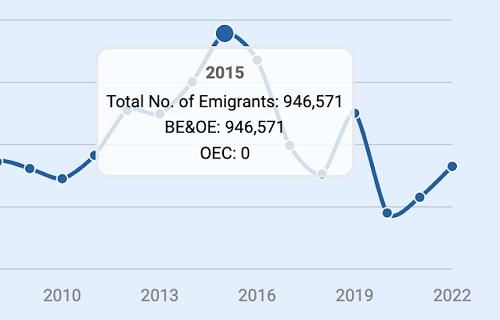
Pakistani workers' overseas migration data (2010-2021) - Bureau of Emigration
The figure of 16.5 million migrants outflow from Pakistan is much higher than the numbers reported by the Bureau of Emigration & Overseas Employment of the Government of Pakistan. A possible source of discrepancy is the uncounted numbers of the family members who accompany workers going abroad for work.
Between 2010 and 2021, 40 countries or territories have experienced a net inflow of more than 200,000 migrants; in 17 of those, the total net inflow exceeded 1 million people. In 2020, Turkey hosted the largest number of refugees and asylum seekers worldwide (nearly 4 million), followed by Jordan (3 million), the State of Palestine (2 million) and Colombia (1.8 million). Other major destination countries of refugees, asylum seekers or other persons displaced abroad were Germany, Lebanon, Pakistan, Sudan, Uganda and the United States of America.
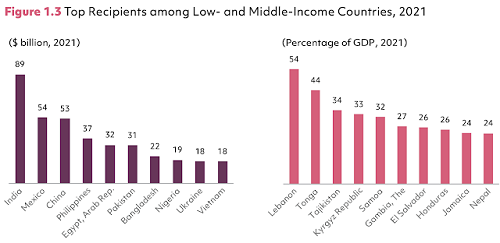
Top remittance receiving countries in 2021 - World Bank
Pakistan has received nearly $31 billion in worker remittances in 2021, up a whopping 20% from the prior year, according to the World Bank. This is a new record approximating nearly 10% of the country's gross domestic product (GDP). This money helps the nation cope with its perennial current account deficits. It also provides a lifeline for millions of Pakistani families who use the money to pay for food, education, healthcare, and housing. This results in an increase in stimulus spending that has a multiplier effect in terms of employment in service industries ranging from retail sales to restaurants and entertainment.
Remittances from the European Union (EU) to Pakistan soared 49.7% in FY 21 and 28.3% in FY22, according to the State Bank of Pakistan. With $2.5 billion remittances in the first 9 months (July-March) of the current fiscal year, the EU ($2.5 billion) has now surpassed North America ($2.2 billion) to become the third largest source of inflows to Pakistan after the Middle East and the United Kingdom. Remittances from the US have grown 21%, second fastest after the EU (28.3%), in the first nine months of the current fiscal year.
Pakistan's share of the working age population (15-64 years) is growing as the country's birth rate declines, a phenomenon called demographic dividend. This dividend is manifesting itself in high levels of worker exports and record remittances pouring into the country. Saudi Arabia and the United Arab Emirates (UAE) are the top two sources of remittances but the biggest increase (58%) in remittances is seen this year from Pakistanis in the next two sources: the United Kingdom and the United States.
Over 10 million Pakistanis are currently working/living overseas, according to the Bureau of Emigration. Before the COVID-19 pandemic hit in 2020, more than 600,000 Pakistanis left the country to work overseas in 2019. The average yearly outflow of Pakistani workers to OECD countries (mainly UK and US) and the Middle East has been over half a million in the last decade.
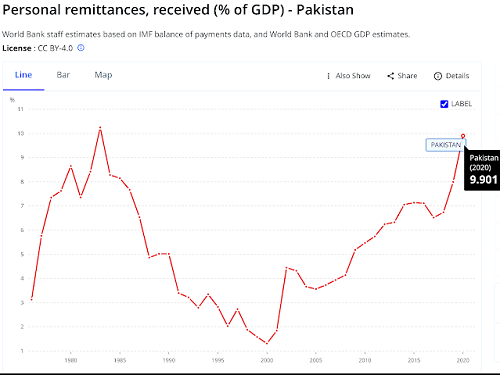
Worker remittances as percentage of Pakistan GDP - World Bank
Pakistan ranks 6th among the top worker remittance recipient countries in the world. India and China rank first and second, followed by Mexico, the Philippines, Egypt, and Pakistan.
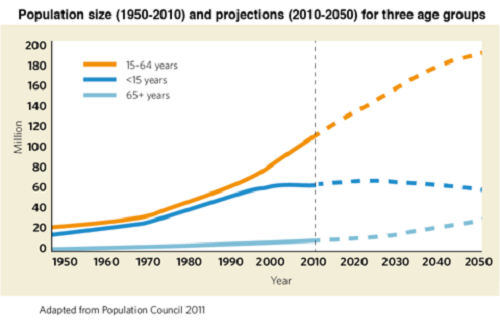
Pakistan demographics
About two million Pakistanis are entering the workforce every year. The share of the working age population in Pakistan is increasing while the birth rate is declining. This phenomenon, known as demographic dividend, is coinciding with declines in working age populations in developed countries. It is creating an opportunity for over half a million Pakistani workers to migrate and work overseas, and send home record remittances.
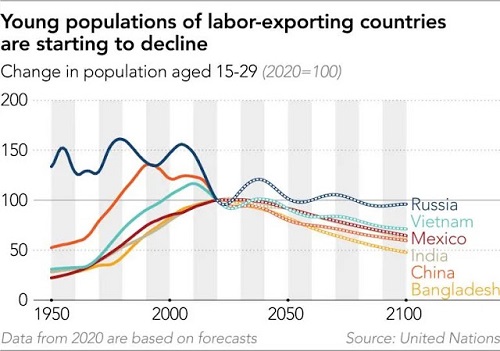
Projected population decline in emerging economies - Nikkei Asia
(Riaz Haq is a Silicon Valley-based Pakistani-American analyst and writer. He blogs at www.riazhaq.com)

